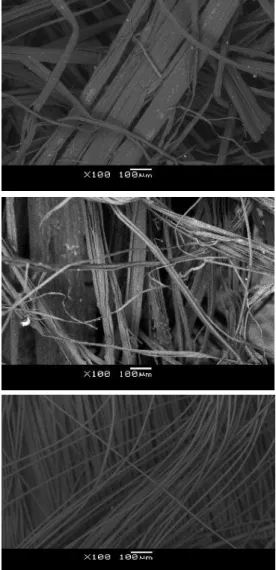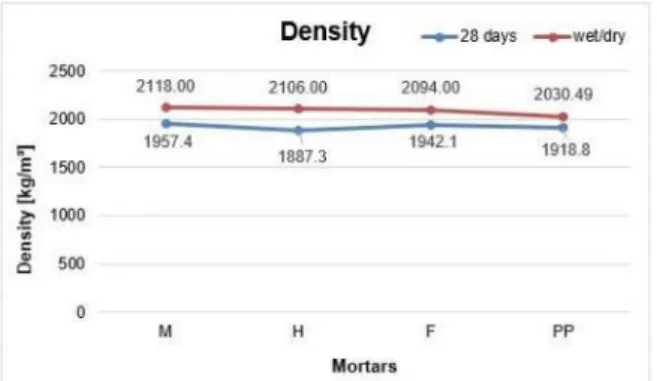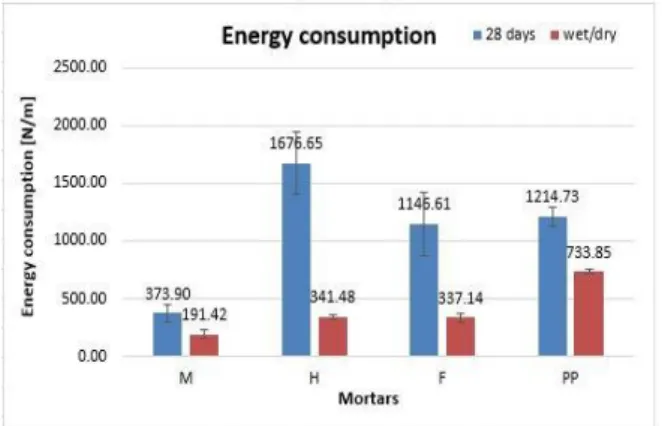3rd International Conference on Bio-Based Building Materials
June 26th - 28th 2019 Belfast, UK
ID_ JJJ295
COMPARISON OF PHYSICAL AND MECHANICAL PROPERTIES OF
CEMENTITIOUS MORTARS REINFORCED WITH NATURAL AND SYNTHETIC
FIBRES PRIOR AND AFTER WET/DRY CYCLES
B. Poletanović1*, I. Merta1, A. Šajna2, A. Mauko Pranjić2, A. Mladenović21 TU Wien, Vienna, Austria
2 Slovenian National Building and Civil Engineering Institute, Ljubljana, Slovenia *Corresponding author; e-mail: bojan.poletanovic@tuwien.ac.at
Abstract
In this research, the physical and mechanical properties of cement-based mortars reinforced with hemp, flax and polypropylene fibres, exposed to accelerated aging of wet/dry cycles, were studied and compared with their initial properties, prior aging. The mortar mixture was made with Portland cement as a binder, cement/sand/water ratio of 1:1:0.4 by weight and with sand of particle size between 0.4-0.8mm. As fibre reinforcement short hemp, flax and polypropylene fibres with dosage of 1,0 vol% (volume ratio) within the matrix was used.
The results show that both the density and compressive strength of all composites increased after accelerated aging. The highest density increase was observed by hemp fibre mortars (up to 11.6%) whereas the highest increase in compression strength exhibited flax fibre reinforced mortars (up to 57.97%). When exposed to accelerated aging of wet/dry cycles, all mortars loss their initial flexural strength, however the lowest loss was observed by natural fibre reinforced mortars. Generally, the addition of fibre reinforcement significantly increases the energy consumption capacity under flexure of plain mortars (in case of hemp fibres even by 348%). However, under accelerated aging all composites exhibit a significant loss in their energy consumption capacity under flexure.
Keywords:
Cement-based mortar, Hemp fibre, Flax fibre, Polypropylene fibre, Wet/dry
1 INTRODUCTION
The majority of traditional building materials in infrastructures are made out of the cement-based materials. Concrete, as the second most consumed material in the world after water, is a quasi-brittle material and in order to shift it toward ductile behaviour it needs to be reinforced. Adding fibres (steel, synthetic or glass) to cement-based matrix has been long recognized as a way to enhance the energy absorption capacity and crack resistance of the material [Lee et al. 2019, Fang et al. 2018, Lee et al. 2018]. However, for these fibres non-renewable Earth’s minerals are used and are thus intensive to manufacture and their production contributes to high pollution. Natural fibres, such as hemp, flax, sisal, coir, jute, cotton, etc. have been considered as their sustainable replacement [Silva et al. 2010; M.R.L. Horne 2012, Y.K.Kim 2012, Bella et al. 2014; Merta and Tschegg 2013, Merta 2016, Yan et al. 2016]. In recent decades, natural, plant-based composite materials have been the main focus of research of many academic as well as industrial investigations [Delannoy et al. 2018, Marceau et al. 2017, Evans, T.C. et al. 2015, Merta et al. 2017, Sinka et al. 2018]. Beneficial environmental impact, cost reduction, and worldwide availability of materials are just some of the main advantages of using natural- vs.
artificial materials [Merta et al. 2017, R.M.kozłowski and M.Mackiewicz-Talarczyk 2012].
However, the major challenge to overcome is still the degradation of natural fibres in the alkaline environment of the matrix and consequently the decrease of mechanical properties of the whole composite. [Wei and Meyer 2015, 2017].
This research focuses on the examination and comparison of the physical and mechanical properties of natural and synthetic fibre reinforced cement-based mortars. On standard prism specimens accelerated aging under wet/dry (W/D) cycles are conducted and the composites properties prior and after aging compared.
2 MATERIALS AND METHODS
2.1 Mortar mixture
The mortar matrix used in this study was designed of cement, sand and water with mass ration 1:1:0.4. The cement used is CEM II/B-M (S-L) 32,5R. The grain size of sand was 0.4-0.8mm. The mortar was mixed in a laboratory drum-mixer, the mixture poured into the moulds 40×40×160 mm³, demoulded 24 hours after casting and stored in water for 28 days. Half of the specimens were tested prior, and half after W/D cycles.
2.2 Fibre reinforcement
As reinforcement for the mortar matrix two types of natural fibres were used: industrial hemp (Cannabis
sativa L) and flax (Linum usitatissimum), cultivated and
processed in Hungary. Both fibres have diameter of 8-60 𝜇m, density of 1500 kg/m³, and tensile strength of 310-900 N/mm2 according to the literature [Yan et al. 2016, Abiola 2017]. The fibre bundles are cut to an average length of 10mm and added to the matrix in the volume percentages of 1%vol. Since natural fibres are highly hydrophilic, they are added to the matrix in water saturated surface dry condition.
As a reference, polypropylene (PP) synthetic micro fibres produced by Baumhueter extrusion GmbH in Germany has been used. The diameter of the fibres was 31.7 𝜇m, density 910 kg/m3 and the tensile strength 136.5 N/mm2. The fibres length was 6 mm and they were added to the matrix in the volume percentages of 1%vol.
The geometry and morphology of fibres under Scanning Electron Microscope (SEM) is shown in Fig. 1.
Fig. 1: Morphology of hemp, flax and PP fibres under Scanning Electron Microscope
2.3 Accelerated aging
The durability of the mortars was determined by imposing the specimens to accelerated aging of W/D cycles in controlled laboratory environment. One dry cycle consists of drying in a chamber at 20 °C and 40%
relative humidity, whereas one wet cycle consists of wetting in a chamber at 20 °C and relative humidity higher than 95%. The cycles were started with 3 days of drying, followed by 4 days of wetting. Then 4 days of drying, followed by 3 days of wetting. Afterward this set of cycles was repeated continuously over one year. 2.4 Tests
2.4.1. Bulk density
The bulk density of the samples was calculated as an overage on 3 mortar specimens (40×40×160 mm³) for each group as follows:
𝐷 =𝑀𝑊 (1) where M is the mass and V the volume of the test specimen.
2.4.2. Three point bending test (3PBT) and compressive test
Three point bending- (3PBT) and compressive tests were conducted on both aged (after W/D cycles) and unaged specimens and the materials’ flexural strength, energy consumption capacity under flexure and compressive strength were measured. The tests were carried out on the mechanical testing machine Schenck RSA with a load capacity of 100 kN and a rigidity of 8×10-3 mm/kN at a room temperature of 21°C and relative humidity of 50%. In the bending tests, the load was applied at the middle of the specimens with a span length of 100mm. The compression tests were carried out on one half of the split specimens by applying the compressive force on 40x40mm2 area. All tests were accomplished on 6 identical specimens.
From the load-displacement curves of the 3PBT the flexural strength and energy consumption capacity of the material under flexure were calculated as the peak stress as well as the area under the curve up to a mid-span deflection of 5mm.
3 RESULTS AND DISCUSSION
3.1 Bulk density
The bulk densities of the composites prior and after aging cycles are presented within the Figure 2. The bulk density of the plain mortar is 1957.4 kg/m³. After adding fibres to the matrix generally, the density of composites decreases [Xie et al. 2015]. With the addition of hemp, flax and PP fibres the density of the composites decreased for 3.6, 0.8 and 2% respectively. The reason for the density decrease is due to the air entrapped in the mixture during mixing of the composites resulting in higher porosity of the material. However, the density decrease is still within the 5% margin.
After W/D cycles the density of all composites increased compared to their non-aged counterpart. This could be related to further cement hydratation in composites, which is continue also after the mortars’ age of 28 days. The density increase of non-reinforced mortar after W/D cycles was 8%. The largest increase was observed in case of hemp reinforcement, i.e. 11.6%, whereas composites with flax and synthetic fibres resulted in density increase of solely 7.82% and 5.82% respectively.
Fig. 2: Bulk density of the composites prior and after aging (M-plain mortar, H- hemp fibre reinforced mortar,
F- flax fibre reinforced mortar and PP- PP fibre reinforced mortar)
3.2 Compressive strength
Figure 3. represents the compressive strength of composites prior and after aging. The compressive strength of the plain mortar is 49.64 MPa. according to the literature, after adding short fibres usually the compressive strength decreases [Merta et al., 2017]. Hemp reinforced mortars showed 16.78% decrease in compression strength, whereas flax and PP reinforced mortars 36.96% and 23.11% respectively compared to plain mortars.
After exposed to aging under W/D conditions, all mortar groups markedly increased their compression strength compared to their initial compression. These results correlates with the composites’ density, i.e. increased density after aging results in increased compressive strength. In case of plain, mortar the compression strength increases for 42.37% whereas by hemp- and flax reinforced composites for 33.79% and 57.97% respectively. The most pronounce increase was in case of PP reinforced mortars, i.e. for 61,28%.
Fig. 3: Compressive strength of the composites prior and after aging (M-plain mortar, H- hemp fibre reinforced mortar, F- flax fibre reinforced mortar and
PP- PP fibre reinforced mortar)
3.3 Flexural strength
Figure 4. shows the flexural strength of all mortar groups prior and after aging. The mean value of the plain mortar’s flexural strength is 7.50 MPa. With addition of short discrete fibres the composites flexural strength generally decreases [Merta et al. 2017], however, in
some cases a good fibre-matrix bond could result in slight improvement of the composites flexural strength [Page et al. 2019].
In this study with the addition of natural fibre a slight decrease in flexural strength has been observed, i.e. 4% for hemp fibres and in case of flax fibres 3.47%. However, PP fibre reinforcement resulted in increase of the mortars flexural strength for 21.73%.
After aging all mortar composites exhibited flexural strength decrease compared to the non-aged ones. However, the lowest loss was observed by natural fibre reinforced ones. In case of plain mortars, the decrease of flexural strength after aging was 11.47% whereas by hemp- and flax reinforced mortars solely 4.86% and 8.43% respectively. In case of PP fibre mortars, the strength loss was 8.98%.
Fig. 4: Flexural strength of the composites prior and after aging (M-plain mortar, H- hemp fibre reinforced mortar, F- flax fibre reinforced mortar and PP- PP fibre
reinforced mortar)
3.4 Energy consumption
Generally, with fibre reinforcement the energy consumption capacity of the mortars increase [ Obinna Onuaguluchi and Nemkumar Banthia 2016, Fantilli et al. 2017, Merta et al. 2017]. When the matrix cracks, the fibres bridging the crack are starting to carry stresses and improve the composites post-peak response by shifting it toward quasi-ductile or ductile behaviour. The composites overall failure is could be in such a way postponed. The fibres contribution to energy consumption can be seen in the Figure 5.
Fig. 5: Stress-strain curves of the non-aged composites (M0-plain mortar, H0- hemp fibre reinforced mortar, F0- flax fibre reinforced mortar and
Within the Figure 6 the energy consumption capacity of the composites under flexure prior and after aging is presented. The energy consumption of plain, non-aged mortar was 373.90 N/m. After reinforcing it with fibres the composites energy consumption significantly increase, i.e. in case of hemp fibres by 348%, for flax and PP fibres by 207% and 225% respectively. After aging, the energy consumption capacity under flexure significantly decreased by all composites compared to their non-aged counterparts. In case of plain mortar for 49%, for hemp and flax fibre reinforced composites up to 80% and 71% respectively. PP fibre reinforced composites exhibited lower loss of the energy consumption capacity, about 40%.
This indicated that the aging process under W/D cycles most significantly influences the fibre/matrix interface, i.e. the interfacial bond strength between the fibres and cement matrix resulting in degradation of adhesion and friction between fibres and the matrix. Therefore, for short fibres further usage within the cementitious matrix this interface should be improved. That could be achieved either by fibre treatments or by matrix modification.
Fig. 6: Energy consumption of the composites prior and after aging (M-plain mortar, H- hemp fibre reinforced mortar, F- flax fibre reinforced mortar and
PP- PP fibre reinforced mortar)
4 SUMMARY
Within this research the physical and mechanical properties of cementitious mortar reinforced with short discrete hemp- and flax fibres exposed to accelerated aging (of W/D cycles for one year) are examined. As reference, mortars reinforced with PP fibres were used. Based on the results, the following could be concluded: The addition of short discrete fibres did not change the density of the plain mortars significantly (less than 5%).
After aging, the density of all composites increased compared to their non-aged counterparts. The largest increase was observed by hemp fibre mortars (up to 11.6%).
After aging, all mortars increased their compressive strength in comparison to their unaged counterparts. The most significant increase was observed by flax fibre reinforced mortars (up to 57.97%).
After aging, all mortars loss their initial flexural strength. However, the lowest loss was observed by natural fibre reinforced mortars.
Although the addition of fibre reinforcement initially significantly increases the energy consumption
capacity under flexure of plain mortars (in case of hemp fibres even by 348%), under accelerated aging the composites exhibit a significant loss in the energy consumption capacity.
5 ACKNOWLEDGMENTS
This research was carried out within the bilateral international cooperation project: Durability of sustainable natural fibre cementitious composites in Alpine regions, between the TU Wien and the Slovenian
National Building and Civil Engineering Institute (ZAG) funded by the Federal Ministry of Science, Research and Economy (BMWFW) in Austria under the grant nr. SI 18/2016.
6 REFERENCES
Abiola, O.S. 2017. Natural Fibre Cement Composites. Advanced High Strength Natural Fibre Composites in Construction. Elsevier Ltd.
Alessandro P.Fantilli, SilvioSicardi and FrancescaDotti 2017, "The use of wool as fiber-reinforcement in cement-based mortar", Construction and Building Materials Volume 139, 15 May 2017, Pages 562-569 Bella, G Di, V Fiore, G Galtieri, C Borsellino, and A Valenza. 2014. “Effects of Natural Fibres Reinforcement in Lime Plasters ( Kenaf and Sisal vs . Polypropylene ).” Construction and Building Materials 58: 159–65. Delannoy, Guillaume, Sandrine Marceau, Philippe Glé, Etienne Gourlay, Marielle Guéguen-minerbe, Dinarzed Dia, Issam Nour, and Fabienne Farcas. 2018. “Aging of Hemp Shiv Used for Concrete” 160: 752–62.
Evans, T.C., Gavrilovich, E., Mihai, R.C. and Isbasescu, I., Easyg Llc. 2015. “( 12 ) Patent Application Publication ( 10 ) Pub . No .: US 2006 / 0222585 A1 Figure 1.” Gridbridge 002 (15): 354.
Fang, Yuan, Bing Chen, and Sajjad Yousefi. 2018. “Experimental Research on Magnesium Phosphate Cement Mortar Reinforced by Glass Fiber.” Construction and Building Materials 188: 729–36. Lee, S, Y Park, and A Abolmaali. 2019. “Investigation of Flexural Toughness for Steel-and-Synthetic-Fiber Reinforced Concrete Pipes.” Structures 19 (January): 203–11.
Lee, Su-jin, Yerin Hong, Ah-hyeon Eom, and Jong-pil Won. 2018. “E Ff Ect of Steel Fi Bres on Fracture Parameters of Cementitious Composites.” Composite Structures 204 (July): 658–63.
Marceau, Sandrine, Philippe Glé, Marielle Guéguen minerbe, Etienne Gourlay, Sandrine Moscardelli, Issam Nour, and Sofiane Amziane. 2017. “Virtual Special Issue Bio Based Building Materials Influence of
Accelerated Aging on the Properties of Hemp Concretes.” Construction and Building Materials 139: 524–30.
Merta, I, and E K Tschegg. 2013. “Fracture Energy of Natural Fibre Reinforced Concrete.” Construction and Building Materials 40: 991–97.
Merta, Ildiko, Ana Mladenovič, Janez Turk, Aljoša Šajna, and Mauko Pranjić. n.d. “Life Cycle Assessment of Natural Fibre Reinforced Cementitious Composites.” 2017
Merta, Ildiko, Aljoša Šajna, Bojan Poletanović, and Ana Mladenović. n.d. “Influence of Natural Fibres on Mechanical Properties and Durability of Cementitious Mortars 1 Introduction 2 Materials and Methods,” 2017, 1–8.
M.R.L. Horne 2012., "6 - Bast fibres: hemp cultivation and production", Handbook of Natural Fibres Types, Properties and Factors Affecting Breeding and Cultivation Volume 1 in Woodhead Publishing Series in Textiles 2012, Pages 114-145
Obinna Onuaguluchi and Nemkumar Banthia 2016, Plant-based natural fibre reinforced cement composites: A review, Cement and Concrete Composites Volume 68, April 2016, Pages 96-108 Page, Jonathan, Fouzia Khadraoui, Moussa Gomina, and Mohamed Boutouil. 2019. “Influence of Different Surface Treatments on the Water Absorption Capacity of Flax Fibres : Rheology of Fresh Reinforced-Mortars and Mechanical Properties in the Hardened State.” Construction and Building Materials 199: 424–34. R.M.kozłowski and M.Mackiewicz-Talarczyk 2012. " 1 - Introduction to natural textile fibres" Handbook of Natural Fibres Types, Properties and Factors Affecting Breeding and Cultivation Volume 1 in Woodhead Publishing Series in Textiles 2012, Pages 1-8
Silva, Flávio De Andrade, Romildo Dias, Toledo Filho, João De Almeida, Melo Filho, Eduardo De Moraes, and Rego Fairbairn. 2010. “Physical and Mechanical Properties of Durable Sisal Fiber – Cement
Composites.” Construction and Building Materials 24 (5): 777–85.
Sinka, Maris, A Pina, P Ferrão, J Fournier, B Lacarrière, and O Le Corre. 2018. “ScienceDirect ScienceDirect ScienceDirect ScienceDirect In-Situ Measurements of Hemp-Lime Insulation Materials for Energy Efficiency Improvement The 15th International In-Situ
Measurements of Hemp-Lime Insulation Materials for Energy Efficiency Assessing the Feasibility of Improvement Using the Heat Demand-Outdoor Temperature Function for a Long-Term Demand
Forecast , Stanislavs District Gendelis b Heat.” Energy Procedia 147: 242–48.
Wei, Jianqiang, and Christian Meyer. 2015.
“Degradation Mechanisms of Natural Fiber in the Matrix of Cement Composites.” Cement and Concrete Research 73 (July): 1–16.
Wei, Jianqiang, and Christian Meyer. 2017. “Degradation of Natural Fiber in Ternary Blended Cement Composites Containing Metakaolin and Montmorillonite.” Corrosion Science 120: 42–60. Xie, Xiaoli, Zuowan Zhou, Man Jiang, Xiaoling Xu, Zeyong Wang, and David Hui. 2015. “Cellulosic Fi Bers from Rice Straw and Bamboo Used as Reinforcement of Cement-Based Composites for Remarkably Improving Mechanical Properties.” Composites Part B 78: 153–61.
Yan, Libo, Bohumil Kasal, and Liang Huang. 2016. “A Review of Recent Research on the Use of Cellulosic Fibres, Their Fibre Fabric Reinforced" Composites Part B Engineering 92:94-132
Y.K. Kim 2012, 8 - Natural fibre composites (NFCs) for construction and automotive industries, Handbook of Natural Fibres Processing and Applications Volume 2 in Woodhead Publishing Series in Textiles 2012, Pages 254-279


